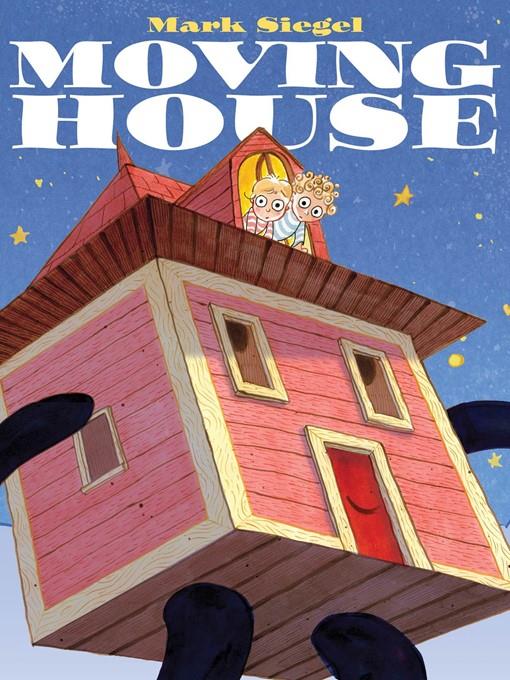
Moving House
فرمت کتاب
ebook
تاریخ انتشار
2011
Reading Level
0-2
ATOS
2.8
Interest Level
K-3(LG)
نویسنده
Mark Siegelناشر
Roaring Brook Pressشابک
9781429961417
کتاب های مرتبط
- اطلاعات
- نقد و بررسی
- دیدگاه کاربران
نقد و بررسی

Starred review from June 27, 2011
Foggytownârendered evocatively in misty gray panelsâused to be nice, "before the factory"; now no one can see the stars anymore. Chloe and Joey's father and mother plan to move away, but the children, who love their house, with its warm spot in the kitchen and its "long vrooming hallway," wish the house could go with them. In the middle of the night, the houseâdrawn with spindly arms and legs and a concerned expressionâ"wiggled and jiggled, and everything went whoa this way and whoa that way." "Hang on tight, little people!" the house says lovingly as it takes them up through the fog to see the stars. In his authorial debut, Siegel's (Boogie Knights) background as an illustrator (and an editor) serve him well; his vignettes and spreads are drafted in clean ink lines, with watercolor washes of blue and red signaling the clean skies above Foggytown. He's crafted a strong story, too, one in which the environmental theme figures largely, but doesn't overpower its greatest drawâthe victory of Chloe and Joey's dreams over their parents' "sensible" plans. Ages 3â6.

August 1, 2011
This contemporary eco-fable suffers from a lack of internal logic, but the positive message and attractive retro artwork may still find favor with progressive parents.
Joey and Chloe, two round-eyed, round-headed tykes, arrive home one day to find their parents packing. The fog in Foggytown, they say, has gotten too thick, and it's time to move. Unhappy at the prospect of leaving their beloved home, Chloe and Joey both wish that the house could come with them—and, in a surreal sequence, it does. The house's friends, including the schoolhouse, library and a row of friendly streetlights come along. The animated house is a particularly appealing character with black arms and legs and bright-red paint that stands out well against the generally grey and blue backgrounds. Siegel's artwork varies from smoky sepia-toned silhouettes to crisply drawn vignettes to cartoon-style full-color double-page spreads. The text, while lengthy and occasionally didactic, has a pleasing flow and offers several lovely images, including "the warm spot on the kitchen floor where we drink our milks every morning" and the "long vrooming hallway." What's less effective is the characterization of the factory's output as "fog" rather than smog, the family's decision to move away from the problem not solve it and the arbitrariness of the house's sudden mobility.
A stronger message and more coherent magic would have made this charming story even more appealing. (Picture book. 4-7)
(COPYRIGHT (2011) KIRKUS REVIEWS/NIELSEN BUSINESS MEDIA, INC. ALL RIGHTS RESERVED.)

August 1, 2011
K-Gr 1-"The fog in Foggytown was so thick that people bumped into parking meters. And streetlamps. And each other." Siegel uses richly textured charcoals to evoke a town overshadowed by the tall smokestacks of a factory. But the overpowering pollution isn't the focus of the plot; instead, it's the fact that Joey and Chloe have never seen the stars, and that their parents are so fed up with the fog that they decide-against their youngsters' objections-to move. The artwork becomes more colorful and kinetic as the artist portrays the children's special rooms, spaces, and memories, as well as the house itself, which tilts, wiggles, jiggles, and trots up the hillside, until it "popped out of the fog." Finally, the youngsters have their first views of the deep blue, gold-flecked night sky. While the text at this point gets muddled with conversations among the town's buildings and lampposts, what's happening-accompanied by delightful illustrations-is that all the structures are migrating uphill. In the morning, Joey, Chloe, and their parents peek outside and find themselves above the clouds where they can see for miles. It's disappointing that the town's pollution, which jump-starts the action, is only important here insofar as it affects the view. The issue of having to leave behind a familiar home is likewise avoided in favor of a more whimsical plot. The pictures are varied and evocative, and the affectionate relationship between the children and their house forms the tender core of this wobbly story.-Susan Weitz, formerly at Spencer-Van Etten School District, Spencer, NY
Copyright 2011 School Library Journal, LLC Used with permission.

September 15, 2011
Preschool-G Joey and Chloe, who live in the thick, charcoal-like goop of Foggytown, are shocked to return home and find their parents packing up.. Although they appreciate the prospect of finally being able to see some stars, they're sad to leave their old house and its warm spots, slideable hallways, and hidden attic alcoves. To their pop-eyed delight, that night the house decides to up and move itself. It marches and dances down the street (pausing to mourn a falling-apart home and say, That will happen to me if you leave me) until it finds a suitable perch on a hill above the fog. Then, the library and schoolhouse and other friendly buildings are invited up into the clear, starry air. Siegel's utterly charming, unusual compositions float visual and textual elements freely about the page. As so much happens in the fringes and in small relief, this is a picture book built for laps instead of groups, or better yet as a story for independent readers. Both whimsical and meaningful, it speaks to a child's powerful attachment to home.(Reprinted with permission of Booklist, copyright 2011, American Library Association.)

























دیدگاه کاربران